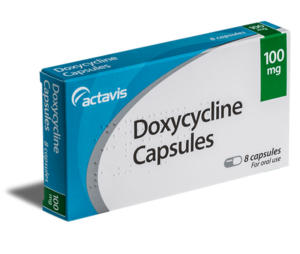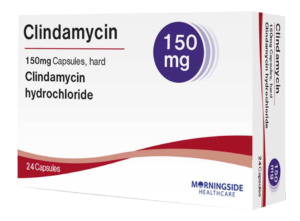Doxycycline
Doxycycline Uses : For treatment of infections caused by bacteria and certain parasites. Doxycycline is a broad-spectrum tetracycline class antibiotic subscribed for treatment of bacterial pneumonia, acne, chlamydia infections, Lyme disease, cholera, typhus, syphilis. urinary tract infections, intestinal infections, respiratory infections, eye infections, gonorrhea, periodontitis (gum disease), and others. It is also used to prevent malaria in combination with quinine. Doxycycline works by stopping the growth of bacteria when treating bacterial infections and is also thought to have an anti-inflammatory action when used for other conditions.
Generic Name: doxycycline
Brand names: Doryx, Mondoxyne NL, Monodox, Morgidox, Okebo, Oracea, Acticlate, Adoxa CK, Adoxa Pak, Adoxa TT, Alodox, Avidoxy, Oraxyl, Periostat Targadox, Vibramycin calcium, Vibramycin Hyclate, Vibramycin monohydrate, Vibra-Tabs.
Drug classes: Tetracyclines.

Doxycycline (Tetracyclines) commonly prescribed for Acne, Bacterial infection, Sinus Irritation and Congestion, Lyme Disease, Skin Infection, Pneumonia, Bronchitis, Malaria and Chlamydia.
Common Doxycycline Adult Dose For:
→ Acne
→ Actinomycosis
→ Amebiasis
→ Bronchitis
→ Bacterial Infection
→ Chancroid
→ Inclusion Conjunctivitis
→ Mycoplasma Pneumonia
→ Pneumonia
→ Trachoma
→ Upper Respiratory Tract Infection.
→ Urinary Tract Infection
ORAL Medication
- Initial dose 200 mg orally on the first day, given in 2 divided doses (100 mg every 12 hours)
- Maintenance dose can be 100 mg orally once a day or 50 mg orally every 12 hours
- More severe infections 100 mg orally every 12 hours
Doryx(R) MPC
- Initial dose is 240 mg orally on the first day, given in 2 divided doses (120 mg every 12 hours)
- Maintenance dose can be 120 mg orally once a day or 60 mg orally every 12 hours
- More severe infections 120 mg orally every 12 hours
IV Medication
- Initial dose: 200 mg IV on the first day, given in 1 or 2 infusions
- Maintenance dose: 100 to 200 mg/day IV
Common Sinusitis Dose for Adult
100 mg orally twice a day or 200 mg orally once a day
Common Lyme Disease Dose for Adult
100 mg orally twice a day
Therapy Duration
- Acrodermatitis Chronica atrophicans: 21 days
- Lyme Cardiac disease: 14 to 21 days
- Lyme Erythema migrans: 10 to 21 days
- Lyme arthritis: 28 days
- Lyme Disease Neurologic: 14 days
Common Skin or Soft Tissue Infection Dose for Adult
Initial dose 200 mg IV on the first day, given in 1 or 2 infusions
Maintenance dose 100 to 200 mg/day IV
Common Malaria Dose for Adult
100 mg orally twice a day for 7 days
In Severe Case: 100 mg orally or IV twice a day for 7 days
Common Chlamydia Infection Dose for Adult
100 mg orally twice a day or 200 mg orally once a day
Therapy Duration: 7 days
Common Doxycycline Pediatric Dose For:
→ Acne
→ Actinomycosis
→ Amebiasis
→ Bronchitis
→ Bacterial Infection
→ Chancroid
→ Inclusion Conjunctivitis
→ Mycoplasma Pneumonia
→ Pneumonia
→ Trachoma
→ Upper Respiratory Tract Infection.
→ Urinary Tract Infection.
ORAL Dose
Less than 45 kg:
All patients with severe or life-threatening infections: 2.2 mg/kg orally every 12 hours
Patients older than 8 years with less severe infections:
Initial dose: 4.4 mg/kg orally on the first day, given in 2 divided doses
Maintenance dose: 2.2 mg/kg orally once a day or 1.1 mg/kg orally twice a day
At least 45 kg:
Initial dose: 200 mg orally on the first day, given in 2 divided doses (100 mg every 12 hours)
Maintenance dose: 100 mg orally once a day OR 50 mg orally every 12 hours
More severe infections: 100 mg orally every 12 hours
Doryx(R) MPC Dose
Less than 45 kg:
All patients with severe or life-threatening infections: 2.6 mg/kg orally every 12 hours
Patients older than 8 years with less severe infections:
Initial dose: 5.3 mg/kg orally on the first day, given in 2 divided doses
Maintenance dose: 2.6 mg/kg orally once a day or 1.3 mg/kg orally twice a day
At least 45 kg:
Initial dose: 240 mg orally on the first day, given in 2 divided doses (120 mg every 12 hours)
Maintenance dose: 120 mg orally once a day or 60 mg orally every 12 hours
More severe infections: 120 mg orally every 12 hours
IV Dose
Less than 45 kg:
All patients with severe or life-threatening infections (e.g., RMSF): 2.2 mg/kg IV every 12 hours
Patients older than 8 years with less severe infections:
Initial dose: 4.4 mg/kg IV on the first day, given in 2 infusions
Maintenance dose: 2.2 mg/kg IV once a day or 1.1 mg/kg IV twice a day
At least 45 kg:
Initial dose: 200 mg IV on the first day, given in 1 or 2 infusions
Maintenance dose: 100 to 200 mg/day IV
Common Chlamydia Infection Dose for Pediatric
8 years or older: 100 mg orally twice a day for 7 days.
Common Skin or Soft Tissue Infection Dose for Pediatric
Less than 45 kg
All patients with severe or life-threatening infections: 2.2 mg/kg IV every 12 hours
Patients older than 8 years with less severe infections
- Initial dose: 4.4 mg/kg IV on the first day, given in 2 infusions
- Maintenance dose: 2.2 mg/kg IV once a day or 1.1 mg/kg IV twice a day
At least 45 kg
- Initial dose: 200 mg IV on the first day, given in 1 or 2 infusions
- Maintenance dose: 100 to 200 mg/day IV
Common Lyme Disease Dose for Pediatric
8 years or older: 2 mg/kg orally twice a day
Maximum dose: 100 mg/dose
Therapy Duration
- Acrodermatitis chronica atrophicans: 21 days
- Cardiac disease: 14 to 21 days
- Erythema migrans: 10 to 21 days
- Lyme arthritis: 28 days
Common Malaria Dose for Pediatric
8 years or older:
2.2 mg/kg orally every 12 hours for 7 days
Maximum dose: 100 mg/dose
Severe Case:
- Less than 45 kg: 2.2 mg/kg orally or IV every 12 hours
- At least 45 kg: 100 mg orally or IV twice a day
Therapy Duration: 7 days
You Health Care provide may prescribed Doxycycline for disease or symptoms not listed above on this page. Take doxycycline exactly as prescribed. Do not take Doxycycline in larger or smaller amounts or for longer than recommended. In most Cases Patients reported nausea, vomiting and upset stomach when taken on an empty stomach. Take Doxycycline with food or milk if it upsets your stomach.
Doxycycline side effects
Common side effects
→ Darkened skin color.
→ Loss of appetite.
→ Nausea and vomiting.
→ Mild diarrhea.
→ Skin rash or itching.
→ Upset stomach.
Get medical help if you have any signs of an allergic reaction, Symptoms may include skin rash, fever, swollen glands, flu-like symptoms, muscle aches, severe weakness, unusual bruising, or yellowing of your skin or eyes, hives, difficult breathing, swelling in your face or throat.
Disclaimer
Medarchive.us does not assume any responsibility for any aspect of healthcare administered with the aid of materials provided. The information contained herein is not intended to cover all possible uses, directions, precautions, warnings, drug interactions, allergic reactions, or adverse effects. The information provided on our Web or Videos does not endorse drugs, diagnose patients, or recommend therapy. If you have questions about the medication you are taking or want to start as treatment, check with your doctor or medical health care provider.





